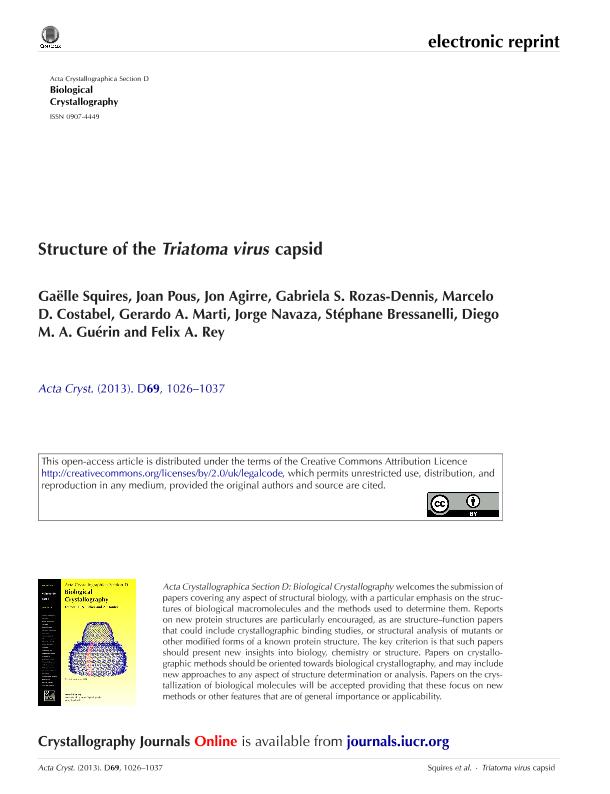Artículo
Structure of the Triatoma virus capsid
Squires, Gaëlle; Pous, Joan; Aguirre, Jon; Rozas Dennis, Gabriela Susana; Costabel, Marcelo Daniel; Marti, Gerardo Anibal ; Navaza, Jorge; Bressanelli, Stéphane; Guérin, Diego Marcelo Alejandro
; Navaza, Jorge; Bressanelli, Stéphane; Guérin, Diego Marcelo Alejandro ; Rey, Felix A.
; Rey, Felix A.
 ; Navaza, Jorge; Bressanelli, Stéphane; Guérin, Diego Marcelo Alejandro
; Navaza, Jorge; Bressanelli, Stéphane; Guérin, Diego Marcelo Alejandro ; Rey, Felix A.
; Rey, Felix A.
Fecha de publicación:
04/2013
Editorial:
Wiley Blackwell Publishing, Inc
Revista:
Acta Crystallographica Section D-Biological Crystallography
ISSN:
0907-4449
Idioma:
Inglés
Tipo de recurso:
Artículo publicado
Clasificación temática:
Resumen
The members of the Dicistroviridae family are non-enveloped positive-sense single-stranded RNA (+ssRNA) viruses pathogenic to beneficial arthropods as well as insect pests of medical importance. Triatoma virus (TrV), a member of this family, infects several species of triatomine insects (popularly named kissing bugs), which are vectors for human trypanosomiasis, more commonly known as Chagas disease. The potential use of dicistroviruses as biological control agents has drawn considerable attention in the past decade, and several viruses of this family have been identified, with their targets covering honey bees, aphids and field crickets, among others. Here, the crystal structure of the TrV capsid at 2.5 A ˚ resolution is reported, showing that as expected it is very similar to that of Cricket paralysis virus (CrPV). Nevertheless, a number of distinguishing structural features support the introduction of a new genus (Triatovirus; type species TrV) under the Dicistroviridae family. The most striking differences are the absence of icosahedrally ordered VP4 within the infectious particle and the presence of prominent projections that surround the fivefold axis. Furthermore, the structure identifies a second putative autoproteolytic DDF motif in protein VP3, in addition to the conserved one in VP1 which is believed to be responsible for VP0 cleavage during capsid maturation. The potential meaning of these new findings is discussed
Palabras clave:
Triatoma virus
,
Trv
,
Cripavirus
,
Dicistroviridae
Archivos asociados
Licencia
Identificadores
Colecciones
Articulos(CEPAVE)
Articulos de CENTRO DE EST.PARASITOL.Y DE VECTORES (I)
Articulos de CENTRO DE EST.PARASITOL.Y DE VECTORES (I)
Citación
Squires, Gaëlle; Pous, Joan; Aguirre, Jon; Rozas Dennis, Gabriela Susana; Costabel, Marcelo Daniel; et al.; Structure of the Triatoma virus capsid; Wiley Blackwell Publishing, Inc; Acta Crystallographica Section D-Biological Crystallography; 69; 4-2013; 1026-1037
Compartir
Altmétricas



